April 19,2018 Update
Through creation of a magnitude index which creates a single vector out of data for release, run out and deaths, we have confirmed that the Fundao is the largest failure in recorded history with a magnitude score of 41.42. For that scoring we used the official final finding of the government, 45 million cubic meters.
The following chart is excerpted from our as yet unpublished technical documentation on the index.
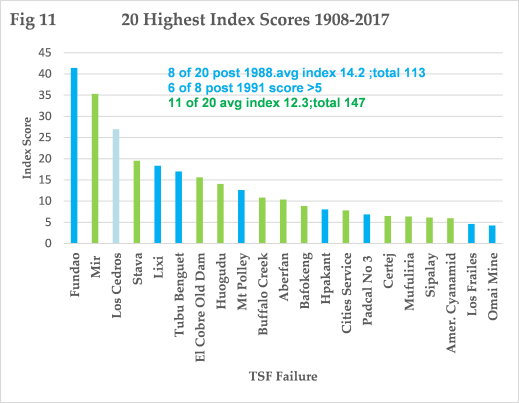
At the time this post was made, shortly after the failure and well before any studies, WISE was reporting 32 million cubic meters and I believe still does. There is still no accounting of what contents were lost from the Santorem as the Fundao tailings washed over it. The government’s official 45 million apparently includes subsequent losses at the Fundao as well as the Santorem.
The Working Group met with State authorities, business, civil society and community representatives in Minas Gerais. The State has the highest concentration of industrial mines in Brazil, and the Working Group’s visit took place after the tragic disaster caused by the 5 November rupture of the Fundão tailing dam, in the district of Mariana. The disaster is referred to as the worst environmental disaster in Brazil.
Foreword
The statistical analysis presented in this report uses the best currently available authoritatively cited data on the severity of the November 5 Samarco dam failure on the only two measures of severity systematically recorded in global history for all significant incidents and failures of tailings dams since 1910: “Release” the volume of tailings and water unintentionally released from the tailings facility(TSF); “Runout”, the linear distance from the TSF the release travels. The severity in economic terms is not systematically captured on tailings dams failures in history but recent collaborative) research ( Bowker Chambers 2015) has assembled authoritative documentation on about half of post 1990 catastrophic failures and so we use this research to compare the presently estimated economic damages of the Samarco failure.
On these three best current measures of severity, the Samarco is without question the largest by far in recorded global history.
The figures we use for “release” , and “run out” are those also cited by the United Nationas Working group from their onsite reconnaissance and interviews with mine and government officials. . The figures on “release” are by known contents of the Fundao at failure. This reported 55 million of tailings only at the Fundao makes no account of water volume there. Post failure photos(see below) show there is no trace the Fundao ever existed. Therefore the 55-60 million used by the UN and by Bowker Associates in this report most likely under estimates what will be finally documented as total release.
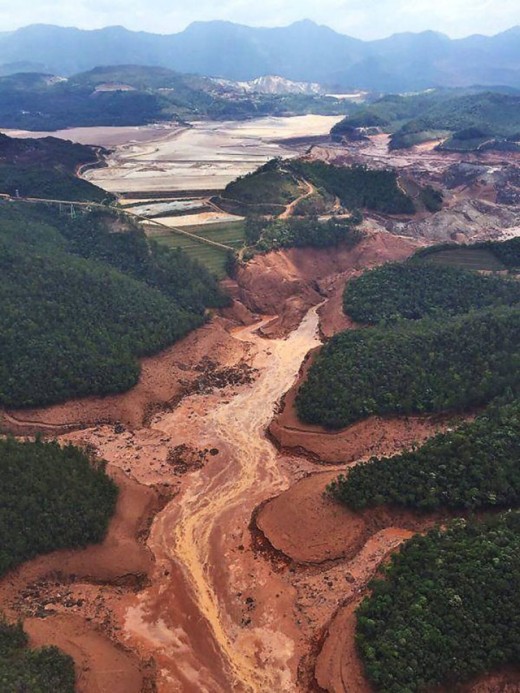
There was also a confirmed release overtopping the Santorem but the details of that and the amounts of water involved have not been specifically disclosed by the Brazilian government or the miners. Photos of the Santorem post failure show extensive damage and loss of contents and structure.
The Samarco Failure In Recorded World History
The November 5th failure of Samarcos’ newly constructed Fundao Tailings Dam1 (c.2010) significantly exceeds the severity of all reported failures 1915-2015 on three measures of severity: volume of release, ( 50-60 2 million cubic meters), run out (500-600 km3), and environmental and other damages.($5.2 billion 4). These three descriptors are independent measures of the scale of offsite damage and the ultimate likely risk of un funded un fundable public liability.
While the exact numbers remain a little “fuzzy”, as is always the case, sometimes for years, following a tailings dam catastrophe, the difference in magnitude relative to past catastrophes makes it unmistakably clear that the Samarco failure is the worst in recorded in history on these three measures of severity.
The “official record” ( Wise/ICOLD as recompiled by Bowker Chambers 2015 (5) has data on release for only 128 (47%) of 269 recorded adverse events (inclusive of Samarco). 157 (58%) had data on run out. There is also no systematic capture of data on offsite damages including liability damages to impacted residents and businesses. More than 1 year past Mt Polley, there is still no official accounting of loss and damage. Competent, informed estimates are available for only 8 of 18 ,62% catastrophic events post 1995 )
The cumulative release and runout by decade historically ending on the date of this man made and avoidable catastrophic failure, makes it very clear that despite the difference in magnitude the Samarco man made catastrophe is on a very clear trend line to TSF failures of greater consequence.
RELEASE
The release was initially esitmated and acknowledged by BHP at 60 million cubic meters. and estimate that was based on the total taolings in the Fundao and the Santorem which was also initially believed to have failed completely8). BHP has more recently stated that the Fundao contained an estimated 50 million of tailings and that there was no breach at the other two dams in the complex, the Santorem and the Germano. An entirely new number has appeared at WISE, and in a recent university report on damages, 35 million cubic meters but without source or explanation. Brazilian officials are still citing 60 million. In any of these cases 35 million to 60 million, it is still the largest release in recorded history . The next largest , Tubu, #2 ,Benguet Philippines (1/2/92) , was 32.2 million cubic meters. Only 5 tailings dams in recorded history have exceeded 10 million cubic meters of release.
In the following charts we have chosen the figure 60 million cubic meters as an estimate of total release not because it is the highest estimate but because it is most consistent with the miner reported 50 million cubic meters of tailings in the dam as of release, not accounting for water , with photos which show a complete loss of all material from the Fundao ( water and tailings) and most consistent with the scant data on throughput and likely generation of wet aligns from that throughput. Bowker Associates thinks it likely the actual final documented data on “release”, total volume of contents, water & tailings, lost from both dams, may well exceed 60 million cubic meters especially when the overtopping from the overwhelmed Santorem is factored in.
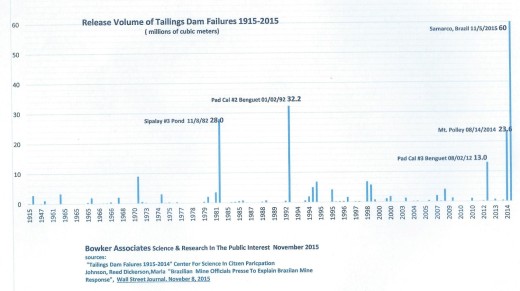
Bowker Chambers (2015) (6) set 1 million cubic meters or more as the threshold for a “very serious failure”. In recorded history through 11/05/15, the date of the Samarco failure, 1915-2015 there have been only 70 “very serious” failures. (This includes one newly documented catastrophe in Mexico in 1937 that has only recently been authortaively described) The larger and higher the facility the greater the release volume. The chart above puts the magnitude of this failure, as measured by release volume in historical perspective.using Bowker Associates best estimate of 60 million cubic meters based on photos, scattered documentation on tailings contents, water & tailings, and an estimate from an SEC filing of total wet tailings generated by Samarco from 2010 through 2014.( over 90 million cubic meters).
Where Are We In History On Release Volume Trends?
The chart below shows the trend in aggregate release volume by decade from 11/6/55-11/5/2015 for the 129 failures, unintended releases and significant events with data recorded on release volume. The exponential increase in total volume of release from all events has escalated from only 6 million cubic meters for the decade ending 11/5/65 to 107 milion cubic meters for the decade ending on the date of the Samarco failure, 11/5/2015.
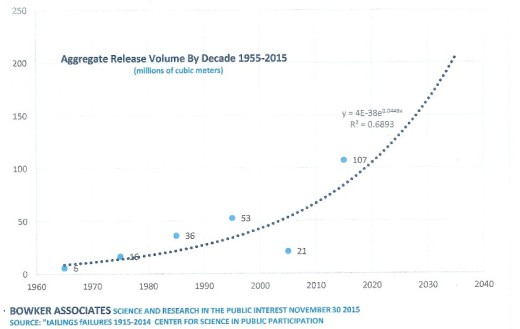
On the basis of this high R Squared exponential fit we can predict the aggregate for the decade ending 11/5/2025 to be 123 million cubic meters. In addition to the absence of any documentation for 123 of 269 events (46%),. two “very serious” failures in the decade ending 11/5/2005 had no data on release at all. They were classified based on other authoritative documentation on severity. Assuming the distribution of release values is the same within each decade, then a correction for under reporting on a straight percentage basis would put the estimated aggregate release volume globally for the decade ending 11/5 2025 at 267 million cubic meters. A conservative estimate is that It will be more than double what it has been for the decade ending 11/5/15.
RUN OUT
Run out is the distance from the point of failure the released contents (tailings and stored /accumulated water) travels. For a given volume of retained tailings& water content , higher dams will have a greater run out and therefore affect a larger area. In dams of the same height those with more water or liquid contents will have a longer run out. The likely run out of a dam in design stage can be reasonably well calculated by this simple formula long before a commitment is made to build it taking account of specific local conditions.https://www.ceaa-acee.gc.ca/050/documents_staticpost/80007/97751/Vol3_AppU_RRP_Final_EA_TMA_Assess.pdf
Run out of the Samarco failure has now reached 500-600KM , the upper range twice that of the 2nd largest of 300km at El Porco Bolivia on. August 29, 1996.
There are only 7 events in recorded history with a run out greater than 100KM.

“Official history” has recorded data on runout for only 157, of the 269 authoritatively documented unplanned releases , failures and significant incidents.
The force of the outflow from the Samarco was extremely powerful. The town of Bento Rodriquez 2.5 km from the Fundao was completely destroyed. 8km further downstream a police officer reportedwall of mud 2.5 meters high still flowing. Five year old Emanuely Fernandez was swept out of her fathers arms as he tried to outrun the flow. Her body was found 40 km downstream. (http://www.maisnoticias.net.br/2015/11/corpo-de-emanuely-e-reconhecido-em.html ) The body of a mine worker was found 100km from the mine site..
The outflow was reported estimated at 400 km in the week following the catastrophic failure but has now reached the Atlantic ocean just north of Rio de Janeiro 663 km downstream and still carrying soils and sediments from the flow. The Rio Duco is completely destroyed and some experts have estimaoted it will take 100 years to recover. At its mouth a carpet of dead fish lay on beaches and on the waters surface.
Where We are in History on Trends in Run Out
The following chart aggregates runout by decade for each decade ending on the date of the Samarco catastrophe, 11/05/15. A clearly and dramatically escalating trend is apparent in the data as reported from 126.7 total kilometers for the decade 11/6/55-11/5/65 to 722.2 total kilometers for the decade ending the day of the Samarco failure. A strong R Square to this linear fit supports an estimate of 723.5 for the decade 11/6/2015-11/05/2025. Important to stress again that this is not a full accounting even of the run out for the most serious failures in all history. The actual cumulative run out for all failures, unintended releases and significant incidents this coming decade will significantly exceed what is predicted by this chart based on reporting for only 58% of all incidents. Assuming the same distribution of values within each decade , and accounting for under reporting on that basis puts the actual estimate of cumulative runout for the coming decade) at 1,247 km. without a course correction in the legal framework for permitting and oversight of mines and a concurrent improvement in self-regulation within the industry
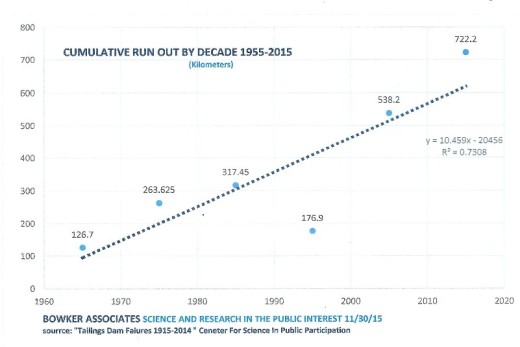
VALUATION OF OFFSITE DAMAGES
Governement prosecutors are suing for damages of $US 5.2 billion based on technical reports and assessment. Researching court records and other government data on “Very Serious Failures”, Bowker Chambers 2015 (6)found only one in recorded history post 1990 with damages as high as $1billion; Taoshi, Linfen City, Xiangfen, Shanxi Province, China, at $1.4 billion ( $2014).
“Valuation” at the scale of these super catstrophe’s is not the same as “cost of clean up” or “remediation” which may not be economically viable or technically achievable.
SUMMARY
It will take a very long time to get authoritative and final confirmation of release volume, runout and estimated offsite damages, however it appears on the basis of what is availlable now that the November 5th dam failure at Samarcos mine in Brazil is without question the largest tailings dam failure in recorded history.
Lindsay Newland Bowker, Managing Director
15 Cove Meadow Rd.
Stonington, Maine 04681
207 367 5145 lindsaynewlandbowker@gmail.com www.lindsaynewlandbowker.wordpress.com
December 12, 2015
FOOTNOTES & REFERENCES ( This needs a major edit but is still useful in this form)
1/Petley, David, “History of the Fundau Dam”, November 10, 2015 last accessed December 3rd at http://blogs.agu.org/landslideblog/2015/11/10/fundao-dam/ This post includes a series of google earth images of the Fundao dam site from virgin earth in 2003 to 2013. The dam first appears as complete and obviously in service in the 2011 photo. The 2013 photo shows a dramatic increase in height from 2011. Photos show an “upstream dam” of extraordinary height.
2/ Release is total contents unintentionally lost from the impoundment and includes total contents, tailings and water. It is clear from the hotos that there is no trace left of the Fundao. All of its contents tailings and water were released. The most recent estimate of tailings at the Fundao alone is 55 million cubic meters, not accounting for water lost. Flow into and over the Santorem which reportedly contained 12 million cubic meters in tailings and a large amount of water has been acknowledged but not documented by officials. Our working estimate of 60 million cubic meters seems a solid best estimate based on all data and photos available to date .
3/Both 500km and 600km have been variously cited..Government is still citing 600 km.WISE is reporting 663Km . For the purposes of our chart work and stats we have elected to use 600km. As a matter of practice we use round whole numbers unless exact measurements are being reported.
4/”Brazil Sues BHP, Vale &Samarco for $7.2 billion Over Mine Disaster” Reuters as reported last Updated Tuesday , December 2, 2015 atABC.Net.AU Last accessed December 3, 2015 http://www.abc.net.au/news/2015-12-01/brazil-sues-bhp-vale-for-5b-dollars-in-damages-for-mine-disaster/6991444 In Brazilian Real the amount cited by Brazilian officials is $US5.2 billion. This is an Australian newsource and the figure $7.2 billion may be in Austraiian dollars . Note, this source also uses 60 million cubic meter release.
5/The “official record” as maintained and publicly accessible ( though not in machine readable download form) is maintaned by the World Information Service on Energy (WISE): Chronology of Major Tailings Dam Failures (from 1960) accesible at http://www.wise-uranium.org/mdaf.html .It’s original core was a survey by ICOLD ( International Committee on Large Dams) complied from anecdotes, recollection and questionnaire through 2000. In the course of research for Bowker Chambers 2015 (6) we noted several omissions in the WISE compilation that were authoritatively documented outside of WISE/ICOLD and also several inconsistencies between the WISE compilation and the original ICOLD compilation as reported in Bulletin 121. The authroitaitvely reconciled and complete accounting, “TSF Failures 1915-2014” is available in excel downloadable form and is what is referred to here aa “the official record”. Bowker Chambers 20156 attempted ,and in a few cases succeeded in ,adding authoritatively sourced detalis on run out, dam height, storage caacity, release, deaths, that were not part of the WISE compilation.. The Bowker Chambers “Official record” is thoroughly sourced and referenced..
6/Bowker, Lindsay Newland Chambers ,David M. “ Risk Economics and Public Liability of Tailings Facility Failures”, Appemdix III published at Earthworks July 2015 Also available at Technical Reorts www.csp2.orgo

Pingback: Fundação Renova aplica mais uma manobra jurídica contra vítimas da maior tragédia ambiental do Brasil – Retalho em palavras